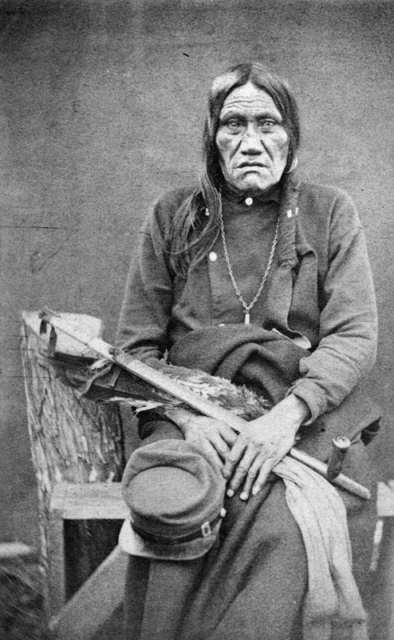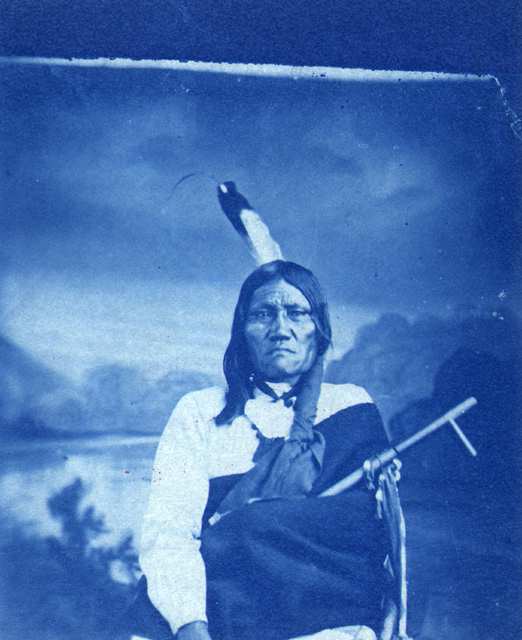|
|
Post by Dietmar on Feb 8, 2010 15:38:12 GMT -5
Here´s my favorite one from that series:  Photograph (black and white) from an album; portrait of (from left to right) Fast Bear, Shotted Tail, John, Long Hair, and Palladay (sitting in the front); Fast Bear is standing on the far left, wearing a hat, and wrapped in a blanket with tassels; Shotted Tail, stands second from the left, wearing a piece of cloth tied around his neck, a shirt, and a blanket wrapped around himself; John is standing on the far right, wearing a hat with a feather and a section of his hair wrapped in cloth and wearing a shirt, and wrapped in a blanket; Long Hair, sits on the far right, with his hair in two section wrapped in cloth, wearing a piece of cloth tied around his neck, a shirt, and a blanket wrapped around himself, whilst holding a pipe(?); Pallasay, sits in the foreground in the centre, wearing a hat, a shirt, and a pair of trousers; in the background on the left, is a western-style building; directly behind the men, is a pile of tree logs; (text from British Museum site) Shotted Tail is of course Sicangu chief Spotted Tail, John is clearly Flatnose John, also a Sicangu. There are other portraits of him, by W.R. Cross for example. Palladay is Leon Palladay, a well known figure at Fort Laramie. Fast Bear should be Quick Bear, the Wazhazha, but because of the hat and it´s shadow I am not 100 percent sure about him. I know nothing about Long Hair. |
|
|
|
Post by kingsleybray on Feb 8, 2010 18:00:10 GMT -5
The Indian named John: on July 8 1872 he was one of six "Chiefs and Headmen of Brule and Ogallalla bands" at Whetstone or White Clay Agency (nr modern Whitney Nebraska, 6ms east of Crawford), signatory to a claim for some horses stolen by white men in March 1868 btw Ft Laramie and Cheyenne.
The signatories all clearly belonged to the Corn-Loafer bands at the agency, viz.
Swift Bear
Thigh
John
Blue Tomahawk
Yellow Hair
Cook
In the lodge tally used for rationing winter 1873-74 at the Brule agency (now moved to the mouth of Beaver Creek northeast of modern Chadron NE), John is listed as among the Brules, credited with 21 lodges. In the Spotted Tail Agency censuses for June and December 1877 he is listed as a family head in the Loafer Band (combined Corn-Loafer camps).
Dietmar could you post what you have on Flatnose John, also the Cross portrait?
Fast Bear looks to be older than the FB in another Gardner 1868 portrait with Spotted Tail. Could this be his father? The robe he wears is interesting, the style of quilled decoration is usually associated with women.
Kingsley
|
|
|
|
Post by Dietmar on Feb 9, 2010 8:37:05 GMT -5
Thanks Kingsley. Here are two portraits of Flatnose John:  Photograph by W.R. Cross  Photo by unknown photographer (available at Denver Public Library) |
|
|
|
Post by ephriam on Feb 9, 2010 9:22:19 GMT -5
Above, two images by Charles W. Carter were posted. Both of these are NOT part of the Gardner, Fort Laramie, series. Instead, they are by Carter, probably taken during his trip to Fort Bridger during the winter of 1866-67. He produced a number of eastern Shoshone views. Some of his original glass plate negatives are preserved in the LDS Church Library here in Salt Lake City.
ephriam
|
|
|
|
Post by grahamew on Feb 9, 2010 13:54:42 GMT -5
I have the lower image credited to Hamilton and Hoyt but I've seen others with the same background credited to Cross and, perhaps inevitably, to Jackson, who seems to get credited for a lot of stuff, whose origins are mysterious... Here's the above-mentioned Cook and his daughter, Grace. 1881?  That's interesting about the robe - Sitting Bull the Oglala wears one in the delegation photo with Red Cloud and Spotted Tail and there's another worn by a man in one of those photos taken at Red Cloud in 1874 - the one with Tavernier, Lt. Carter and Red Dog. |
|
|
|
Post by gregor on Sept 17, 2010 3:23:11 GMT -5
Greetings from Germany, I would like to resume the Gardner discussion. I have a small collection of nearly hundred Gardner images of the Fort Laramie treaty proceedings. For some interested friends I wrote a little book on Gardner, the involved treaty parties and commented the pictures (sorry, only in German). When I was at Fort Laramie, unfortunately I have not paid attention to the locations where Gardner could have shot his photographs. So I tried using the map below to determine the locations.  My number 003 would be this picture:  The number 007 (Crows and Dr. Matthews) this one:  I believe the group is sitting on the foot bridge leading to Brown's hotel. Number 026, the Sutler's residence, this one:  And this one the number 029  And my last example, this one no. 065  The last image may have been developed mirror inverted. Right behind Slow Bull are four buildings in a frontage of buildings. The terrain is a little bit steep and in the background we can recognize a part of the ring fence of the fort. If we look for an appropriate location on the map, then the "BARRACKS" at the parade ground fit best. For an observer - who occupies the position of the photographer - then the buildings should be on the left. Therefore, my presumption that the photo was developed reversed. What do you think? |
|
|
|
Post by palladay on Sept 17, 2013 0:24:50 GMT -5
Here´s my favorite one from that series:  Photograph (black and white) from an album; portrait of (from left to right) Fast Bear, Shotted Tail, John, Long Hair, and Palladay (sitting in the front); Fast Bear is standing on the far left, wearing a hat, and wrapped in a blanket with tassels; Shotted Tail, stands second from the left, wearing a piece of cloth tied around his neck, a shirt, and a blanket wrapped around himself; John is standing on the far right, wearing a hat with a feather and a section of his hair wrapped in cloth and wearing a shirt, and wrapped in a blanket; Long Hair, sits on the far right, with his hair in two section wrapped in cloth, wearing a piece of cloth tied around his neck, a shirt, and a blanket wrapped around himself, whilst holding a pipe(?); Pallasay, sits in the foreground in the centre, wearing a hat, a shirt, and a pair of trousers; in the background on the left, is a western-style building; directly behind the men, is a pile of tree logs; (text from British Museum site) Shotted Tail is of course Sicangu chief Spotted Tail, John is clearly Flatnose John, also a Sicangu. There are other portraits of him, by W.R. Cross for example. Palladay is Leon Palladay, a well known figure at Fort Laramie. Fast Bear should be Quick Bear, the Wazhazha, but because of the hat and it´s shadow I am not 100 percent sure about him. I know nothing about Long Hair. |
|
|
|
Post by palladay on Sept 17, 2013 0:25:22 GMT -5
Leon Palladay is my great-great uncle!  Thanks for posting a pic of him. |
|
|
|
Post by kingsleybray on Aug 23, 2014 8:51:16 GMT -5
|
|
|
|
Post by nicolas (carlo) on Nov 26, 2014 9:47:29 GMT -5
New book on Alexander Gardner's Western Photographs, 1867–1868, should be very interesting: www.amazon.com/Alexander-Gardner-Western-Photographs-Nelson-Atkins/dp/0300208243/ref=pd_ys_nr_b_1Summary: Best known for his Civil War photographs, Alexander Gardner (1821–1882) also created two extraordinary bodies of work depicting the transformation of the American West: Across the Continent on the Kansas Pacific Railway and Scenes in the Indian County. In 1867, after joining the survey team for what became the Kansas Pacific Railroad, Gardner photographed the path of the proposed extension, emphasizing the ease of future railroad construction and economic development, while including studies of American Indians and settlements along the way. The following year, Gardner recorded peace talks with Indian tribes at Fort Laramie, Wyoming. Distinctly sympathetic to the plight of the American Indian, Gardner made candid documentation of individual chiefs, their encampments and daily life, burial trees, and the peace proceedings themselves. With a full catalogue raisonné of these two rare series, Alexander Gardner offers a complete visual index of these remarkable photographs, made at a critical moment in the history of the American West.
|
|
|
|
Post by Dietmar on Nov 26, 2014 12:53:35 GMT -5
Thanks carlo,
sounds interesting indeed. But I wonder if there really new photographs in there and not only those we have seen before.
Does anyone own the book already?
|
|
|
|
Post by nicolas (carlo) on Nov 27, 2014 1:04:54 GMT -5
Given the extensive collection of Gardner photos seen on this board, I share your doubt if there are new ones in the book. However, there may be some information included re. dates, scenes, locations, individual names, etc. that would be new.
If anything, it's at least great that Gardner's western work is given the attention it deserves.
|
|
|
|
Post by grahamew on Nov 27, 2014 12:52:30 GMT -5
My copy's in the post, so we'll see soon enough. I'd love to see prints showing background detail in high res - like those of man Afraid at the council
|
|
|
|
Post by grahamew on Nov 29, 2014 5:56:06 GMT -5
Had a quick look before my wife took it off me to hide it away for Christmas! Handsome book; the Indian country section comprises only a fraction; pretty sure we've seen all the Laramie photos, some of which are reproduced in annoyingly small size - and there are plenty of absences too; surprised the word 'squaw' is used when referring to the Arapaho woman photographed with the white delegates - though, according to some learned voices on PlainsIndianSeminar 2,I gather the person may well be a boy anyhow...
|
|
|
|
Post by grahamew on Dec 7, 2014 5:46:27 GMT -5
Wish we had this larger and clearer - and with some names to put to the faces:  |
|